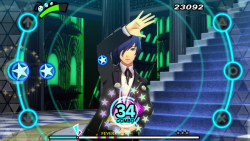I got served… two new Persona dancing games at the same time ⊟
Persona 4 Dancing All Night wasn’t my favorite rhythm game ever, mechanically, but the system worked well enough to act as a worthwhile game vehicle for the series’ astoundingly perfect music.
Atlus has played it entirely safe with the sequels, which makes sense given the difficulty in P4D’s development (Hatsune Miku Project Diva developer Dingo was taken off the project part of the way through) and the fact that the two follow-up games were developed and released simultaneously. That means that the gameplay, which was already good, is… still good, and still acts as a perfectly fine vector for experiencing a ton of remixes of great RPG music. I wouldn’t take any chances if I were making two games at the same time either. I mean, I try to play it safe when selecting breakfast cereals.
The few changes Atlus did make to the formula only improve the experience – especially the experience of trying to play two new games at the same time (or at least in overlapping play sessions). Where Persona 4 Dancing All Night’s story took place in the main game mode – paging through tons of story text was required to progress through the game – the two new games do it the opposite way. The main gameplay mode is just dancing, and playing songs unlocks both new songs and “Social” story segments. It’s possible to play all the songs without bothering with the story altogether, which is kind of a weird thing to say about Persona games, but a welcome option.
Sequestering all the text in its own home streamlines the games, making it easier for me to jump back and forth to play songs from P3 or P5 without having to take narrative breaks. The social stuff will be there when I want it, and the rhythm gameplay is there when I want it. Not only is this friendlier to deal with than P4D, it’s friendlier to people trying to experience both games in parallel.
The game offers proof of how nice it is to be able to choose when to check in with the story… with a single negative example. Both games start with a semi-mandatory sequence (you can skip it, but can’t watch it again later if you do) setting up the story, in which both sets of heroes are told that they’re in a magical dancing world, and both sets of heroes react nearly identically. (Aside: Persona 4 Dancing set up that all the events of the game had real importance and consequences; these games instead establish the dancing as both canon AND completely unimportant to the main plots of their parent games. It’s quite a feat.) While the dialogue is fun, if you happen to be in the position of starting the games one after another, having to deal with the same story beats again is a special kind of agony.
I don’t know if the changes were specifically designed with people who bought the games together in mind, but it’s nice since Atlus does offer the games together (in a box that also includes Persona 4 Dancing). And I know this isn’t the first instance of simultaneous game pairs, but I do know that some features have bundle buyers in mind – like the song and character DLC, which is shared between both games! I appreciate the level of thought that went into this kind of unusual situation.
► THE NEW CLUB TINY IS HERE Support Tiny Cartridge!


